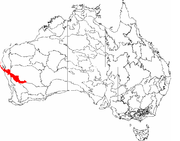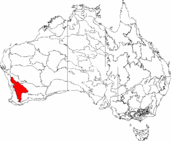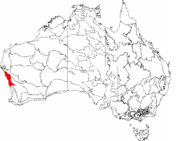
Southwest Australia savanna
Encyclopedia



Ecoregion
An ecoregion , sometimes called a bioregion, is an ecologically and geographically defined area that is smaller than an ecozone and larger than an ecosystem. Ecoregions cover relatively large areas of land or water, and contain characteristic, geographically distinct assemblages of natural...
in Western Australia
Western Australia
Western Australia is a state of Australia, occupying the entire western third of the Australian continent. It is bounded by the Indian Ocean to the north and west, the Great Australian Bight and Indian Ocean to the south, the Northern Territory to the north-east and South Australia to the south-east...
.
Location and description
This dry region is a belt between the Mediterranean climateMediterranean climate
A Mediterranean climate is the climate typical of most of the lands in the Mediterranean Basin, and is a particular variety of subtropical climate...
of the southwest corner and the semi-arid sandplains inland and to the north. Much of the area is now converted to wheat growing.
Flora
Part of the biodiversity hotspotBiodiversity hotspot
A biodiversity hotspot is a biogeographic region with a significant reservoir of biodiversity that is under threat from humans.The concept of biodiversity hotspots was originated by Norman Myers in two articles in “The Environmentalist” , revised after thorough analysis by Myers and others in...
of Southwest Australia
Southwest Australia
Southwest Australia is a biodiversity hotspot that includes the Mediterranean forests, woodlands, and scrub ecoregions of Western Australia. The region has a wet-winter, dry-summer Mediterranean climate, one of five such regions in the world...
this region has been defined by the World Wide Fund for Nature
World Wide Fund for Nature
The World Wide Fund for Nature is an international non-governmental organization working on issues regarding the conservation, research and restoration of the environment, formerly named the World Wildlife Fund, which remains its official name in Canada and the United States...
and contains the Interim Biogeographic Regionalisation for Australia
Interim Biogeographic Regionalisation for Australia
The Interim Biogeographic Regionalisation for Australia is a biogeographic regionalisation of Australia developed by the Australian Government's Department of the Environment, Water, Heritage and the Arts...
(IBRA) regions of the Geraldton Sandplains
Geraldton Sandplains
Geraldton Sandplains is an Interim Biogeographic Regionalisation for Australia region in Western Australia and part of the larger Southwest Australia savanna ecoregion.It has two sub regions: -* Geraldton Hills sub region* Lesuer sub region...
, Avon Wheatbelt
Avon Wheatbelt
Avon Wheatbelt is an Interim Biogeographic Regionalisation for Australia region in Western Australia and part of the larger Southwest Australia savanna ecoregion.-Further reading:...
, and Yalgoo
Yalgoo (biogeographic region)
Yalgoo is an Interim Biogeographic Regionalisation for Australia region in Western Australia and part of the larger Southwest Australia savanna ecoregion.In the IBRA system it has the code of , and it has two sub-regions:...
.
The original habitat consists of savanna
Savanna
A savanna, or savannah, is a grassland ecosystem characterized by the trees being sufficiently small or widely spaced so that the canopy does not close. The open canopy allows sufficient light to reach the ground to support an unbroken herbaceous layer consisting primarily of C4 grasses.Some...
dotted with eucalyptus woodland, mallee woodlands and shrublands
Mallee Woodlands and Shrublands
Mallee Woodlands and Shrublands is a Major Vegetation Group which occurs in semi-arid areas of southern Australia. The vegetation is dominated by mallee eucalypts which are rarely over 6 metres high...
and heath
Heath (habitat)
A heath or heathland is a dwarf-shrub habitat found on mainly low quality acidic soils, characterised by open, low growing woody vegetation, often dominated by plants of the Ericaceae. There are some clear differences between heath and moorland...
. Although in the more fertile southern areas this has now mostly been converted to wheatfields more original savanna remains in the north of the region where there are more acacia
Acacia
Acacia is a genus of shrubs and trees belonging to the subfamily Mimosoideae of the family Fabaceae, first described in Africa by the Swedish botanist Carl Linnaeus in 1773. Many non-Australian species tend to be thorny, whereas the majority of Australian acacias are not...
trees than eucalyptus. Plants of the region include many wildflowers and trees including the scented Acacia rostellifera
Acacia rostellifera
Acacia rostellifera, commonly known as summer-scented wattle or skunk tree is a coastal tree or small tree in the family Fabaceae...
. The best-preserved area of original habitat is found in and around the multi-coloured sandstone gorges of Kalbarri National Park
Kalbarri National Park
Kalbarri National Park is located north of Perth. The major geographical features of the park include the Murchison River gorge which runs for nearly 80 kilometres on the lower reaches of the Murchison River...
on the Murchison River
Murchison River (Western Australia)
The Murchison River is the second longest river in Western Australia. It flows for about from the southern edge of the Robinson Ranges to the Indian Ocean at Kalbarri. It has a mean annual flow of about 200 million cubic metres.-Course:...
.
Fauna
Birds of the area include the emuEmu
The Emu Dromaius novaehollandiae) is the largest bird native to Australia and the only extant member of the genus Dromaius. It is the second-largest extant bird in the world by height, after its ratite relative, the ostrich. There are three subspecies of Emus in Australia...
, although this has been hunted as a pest by the wheat-growing community, and the honey-eating Western Spinebill
Western Spinebill
The Western Spinebill, Acanthorhynchus superciliosus, is a honeyeater found in the heath and woodland of south-western Western Australia. It ranges between long, and weighs around . It has a black head, gray back and wings, with a red band behind its neck and from its throat to its breast. There...
. Mammals include the Honey Possum
Honey Possum
The honey possum or tait, its Native Australian name or noolbenger is a tiny Australian marsupial weighing just seven to eleven grams for the male, and eight to sixteen grams for the female—about half the weight of a mouse. Their physical size ranges from a body length of between 6.5 –...
and the Southwestern Pygmy Possum
Southwestern Pygmy Possum
The southwestern pygmy possum , commonly known as the western pygmy possum or the mundarda, is a small marsupial found in Australia...
, both of which feed on nectar from the wildflowers.

